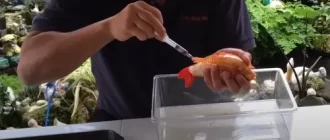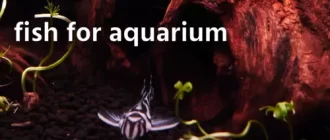Keeping an aquarium at home can be an enjoyable and rewarding experience. But without an air pump, you’ll be in for some serious problems. An air pump is necessary to ensure your aquarium is properly oxygenated, and without it, you may find yourself facing a number of issues. Here are some of the problems you may encounter if you don’t have an air pump:
- Poor Water Quality: With no air pump, the water in your aquarium won’t be oxygenated well. This can lead to poor water quality, which can be damaging to your fish. Poor water quality can cause an increase in ammonia and nitrate levels, which can be extremely toxic. It can also cause an increase in algae growth, making your aquarium look unpleasant.
- Fish Stress: Without an air pump, oxygen levels may drop and fish can become stressed. This stress can lead to a decrease in appetite and an increase in susceptibility to disease. It can also make your fish lethargic and apathetic.
- Poor Filtration: Without an air pump, water won’t be properly oxygenated, leading to poor filtration. Poor filtration can cause an increase in ammonia and nitrate levels, which can be toxic to your fish. It can also increase algae growth and make your aquarium look unappealing.
An air pump is essential for keeping your aquarium healthy and happy. If you haven’t got one yet, make sure you get one soon.
Top 3 Air Pump for Your Fish Tank: Our Pick
There may be a power selection on the product page, depending on the volume of your aquarium. To do this, click on the link (products are listed on Amazon) to find out more.
Types of Air Pumps
Air pumps are an essential tool for any fish tank, as they supply the water with oxygen to keep the fish healthy. Fortunately, there are several types of air pumps available, each with its own advantages and disadvantages. Let’s take a look at the different types and their uses.
The most common type is the diaphragm pump. It uses a diaphragm to create a vacuum, drawing air into the tank. These pumps are relatively quiet and require little maintenance, plus they’re generally inexpensive, making them a great pick for many aquarium owners.
Piston pumps are also available. These pumps use a piston to compress air and push it into the tank. They are more powerful than the diaphragm pumps, making them perfect for larger tanks, but they do come with a bigger price tag and require more upkeep.
Bellows pumps are another option. They use a bellows to draw air into the tank and are quieter than the diaphragm and piston pumps, making them a great choice for smaller tanks. Again, they’re relatively inexpensive and don’t require a lot of maintenance.
Finally, electric air pumps use electricity to draw air into the tank. Electric pumps are more powerful than the other types, making them suitable for larger tanks, but they are pricier and require additional maintenance.
Benefits of Using an Air Pump
An air pump is an essential piece of equipment for any fish tank. Not only does it help to keep the water oxygenated, but it also helps to keep the tank clean and healthy. Here are some of the key benefits of using an air pump in your fish tank.
- Oxygenation: An air pump helps to oxygenate the water in your tank, which is essential for the health of your fish. Without oxygen, your fish will eventually die. An air pump helps to keep the water oxygenated, allowing your fish to stay healthy and happy.
- Cleanliness: An air pump helps to keep the water in your tank clean. It helps to circulate the water, which helps to keep the tank free of debris and other contaminants. This helps to keep your fish healthy and the tank looking its best.
- Aeration: An air pump helps to aerate the water in your tank. This helps to keep the water from becoming stagnant, which can lead to the growth of bacteria and other contaminants. Aeration also helps to keep the water temperature stable, which is important for the health of your fish.
- Noise Reduction: An air pump helps to reduce the noise in your tank. It helps to keep the water moving, which helps to reduce the noise from the filter and other equipment. This helps to keep your tank quiet and peaceful.
Using an air pump in your fish tank is essential for the health and well-being of your fish. It helps to keep the water oxygenated, clean, aerated, and quiet. Investing in an air pump is a great way to ensure that your fish stay healthy and happy.
How to Properly Install an Air Pump
Setting up an air pump in an aquarium is essential for keeping your fish in optimum health and happiness. An air pump oxygenates the water, which your fish need to survive, and also keeps it clean. To ensure that the air pump works correctly, correct installation is essential. Here are some easy tips to get you started:
- Select the Right Air Pump: Start by picking an air pump suitable for your aquarium. Size and type of fish should be taken into account, as well as the amount of oxygen you need to provide.
- Place the Air Pump: Once you have the right air pump, place it in the aquarium. Ensure the pump is not too close to the surface, as this could make the waters turbulent.
- Attach the Air Pump to the Air Stone: Connect the air pump to an air stone, which is a porous rock that diffuses air bubbles. Make sure the air stone is tied securely to the air pump.
- Connect the Air Pump to the Power Outlet: Your air pump should be connected to a power source such as an electrical outlet or battery. Double-check that the power source is suitable for the air pump.
- Run a Test: Turn on the air pump and examine the aquarium for air bubbles. This will show you if the air pump is functioning properly.
By following these five steps, you can easily install an air pump in your aquarium.
Troubleshooting Common Air Pump Issues
Fish tank air pumps are an essential part of any aquarium, providing oxygen to the water and helping to keep the tank clean and healthy. Unfortunately, these pumps can sometimes malfunction, leading to a variety of issues. If your fish tank air pump is having problems, here are some troubleshooting tips to help you get it back up and running.
- Check the power source. Make sure the power source is plugged in and working properly. If the power source is not working, replace it or check the fuse.
- Check the air pump. Make sure the air pump is in good condition and that all the parts are working properly. If the air pump is not working, replace it.
- Check the air tubing. Make sure the air tubing is not clogged or blocked. If the tubing is blocked, clean it out or replace it.
- Check the air stone. Make sure the air stone is not clogged or blocked. If the air stone is blocked, clean it out or replace it.
- Check the water level. Make sure the water level is not too low or too high. If the water level is too low or too high, adjust it accordingly.
By following these troubleshooting tips, you should be able to get your fish tank air pump back up and running. If you are still having problems, contact a professional for help.
Price range of air pumps depending on aquarium volume
When it comes to choosing an air pump for your aquarium, it’s important to consider both the price range and the volume of the aquarium. Air pumps come in a variety of sizes and prices, and the size of the aquarium will determine the size of the air pump you need.
For smaller aquariums, you can get away with a smaller, less expensive air pump. These pumps typically range from $10 to $30 and are suitable for aquariums up to 10 gallons. They are usually powered by batteries or a small electric motor.
For larger aquariums, you will need a more powerful air pump. These pumps range from $30 to $100 and are suitable for aquariums up to 30 gallons. They are usually powered by a larger electric motor and can provide more air flow than smaller pumps.
When choosing an air pump, it’s important to consider the size of the aquarium and the price range you’re willing to spend. Smaller aquariums can get away with a smaller, less expensive air pump, while larger aquariums will require a more powerful pump. By taking into account the size of the aquarium and the price range, you can ensure that you get the right air pump for your needs.
Conclusion
Having an aquarium is a great way to bring a bit of nature into your home. But if you don’t have an air pump, you may be facing some serious problems. Without an air pump, your aquarium will not be able to properly oxygenate the water, which can lead to a number of issues. Here are some of the problems you may face if you don’t have an air pump in your aquarium.
- Poor Water Quality: Without an air pump, the water in your aquarium will not be properly oxygenated. This can lead to poor water quality, which can cause a number of issues. Poor water quality can lead to an increase in ammonia and nitrate levels, which can be toxic to your fish. It can also lead to an increase in algae growth, which can make your aquarium look unsightly.
- Fish Stress: Without an air pump, the water in your aquarium will not be properly oxygenated. This can cause your fish to become stressed, which can lead to a number of health issues. Stress can cause your fish to become lethargic, which can lead to a decrease in appetite and an increase in susceptibility to disease.
- Poor Filtration: Without an air pump, the water in your aquarium will not be properly oxygenated. This can lead to poor filtration, which can cause a number of issues. Poor filtration can lead to an increase in ammonia and nitrate levels, which can be toxic to your fish. It can also lead to an increase in algae growth, which can make your aquarium look unsightly.
Having an air pump in your aquarium is essential for keeping your fish healthy and your aquarium looking its best. If you don’t have an air pump, you may be facing some serious problems. Be sure to get an air pump as soon as possible to avoid these issues.










